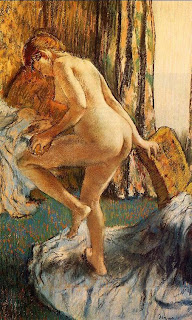Tuesday, May 07, 2013 -  Capitoline Museum,Getty Villa
Capitoline Museum,Getty Villa
 1 comment
1 comment
 Capitoline Museum,Getty Villa
Capitoline Museum,Getty Villa
 1 comment
1 comment
Lion Attacking A Horse Ends Exhibit at Getty Villa; First Time 4th Century BC Greek Statue has been on display since 1925
 |
| Lion Attacking a Horse in the atrium at the Getty Villa (Photo by Catherine Sezgin) |
This is the first time the sculpture has been on public display since 1925 and the first time it has left Rome in 2,000 years.
Depicting the figure of a fallen horse succumbing to the claws and fangs of a ferocious lion, the monumental group dates to the early Hellenistic period (the late 4th century B.C.), when Greek sculptors began to produce naturalistic portrayals of intense emotion and physical exertion.
Although the original location of the sculpture is unknown, its massive scale and dramatic carving suggest that it embellished a monument in northern Greece or Asia Minor (present-day Turkey). Created in the era of Alexander the Great’s conquest of Asia, the sculpture may have formed part of a larger composition with a melee of wild beasts and mounted hunters, which commemorated the young king’s famous lion-hunting exploits at Sidon (present-day Lebanon) in 332 B.C. and a royal game preserve in Basista (present-day Uzbekistan) in 328–327 B.C.
Close-up of Lion (Photo by C. Sezgin)
The sculpture was eventually brought to Rome, most likely as war booty seized by a victorious general for display in the imperial capital. It was ultimately discovered in the streambed near the Circus Maximus, a stadium used for chariot races, gladiatorial games, and animal combats. The work was first mentioned in an archival document in 1300.
 |
| Backside of 4th century BC Greek marble (Photo by Sezgin) |
By 1347, the sculpture was prominently displayed on the Capitoline Hill in Rome, the seat of the city’s civic administration. During this time, Renaissance Rome was experiencing a great rebirth of interest in its glorious ancient past, which served as a model for the present. Remains of antiquity, such as Lion Attacking a Horse, were among the earliest expressions of the Renaissance spirit.
The work was initially installed on the staircase of the Palazzo Senatorio in the Piazza del Campidoglio on the Capitoline Hill. Presiding over an area used for pronouncing judicial sentences since antiquity, this powerful image of domination and retribution served as a symbol of Rome for over a century. In 1471 Pope Sixtus IV transferred a group of ancient bronze sculptures, including the famous statue of a she-wolf suckling the twins Romulus and Remus, from the Lateran Palace to the Piazza del Campidoglio, as reminders of “ancient excellence and virtue.” Mounted on the facade of the Palazzo dei Conservatori, the she-wolf replaced the lion-and-horse image as the emblem of Rome. Lion Attacking a Horse was moved to various places on the Capitoline until it was eventually installed in the center of a fountain in the Caffarelli Garden in 1925.This statue was loaned to the Getty by the Sovraintendenza ai Beni Culturali di Roma Capitale - Musei Capitolini with funding provided by the Knights of Colombus and the J. Paul Getty Museum's Villa Council.








